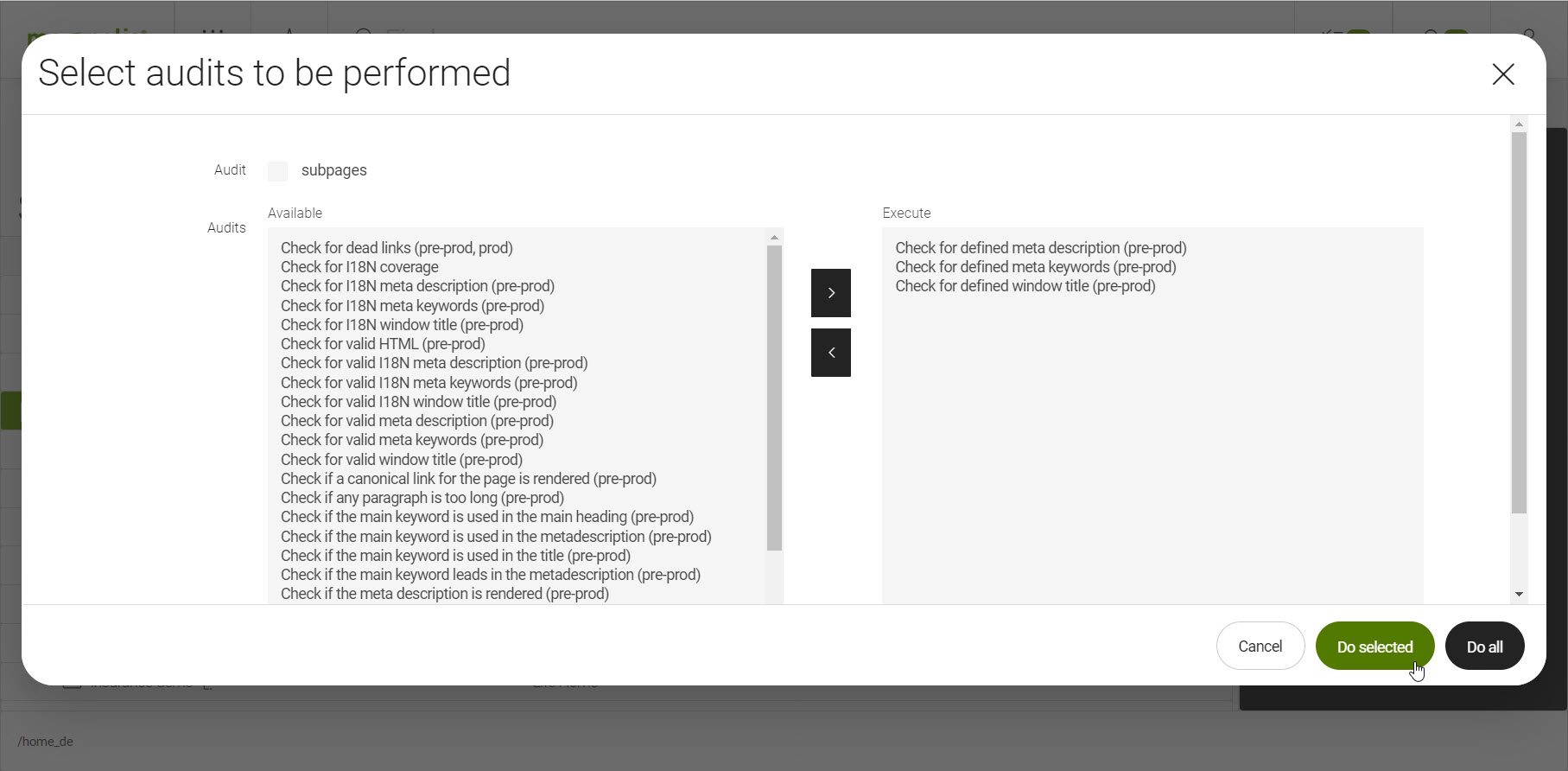SEO module
Search and discovery Unbundled: Extension
Issues |
|||
Git |
|||
Latest |
|
The Search Engine Optimization (SEO) module provides tools for analyzing and validating content in your JCR repository. Typically it is used to analyze pages to ensure the best SEO quality and full acessibility (AAA rating) before publication.
It can also be used to analyze any type of content node in any workspace for specific quality gates. The module contains a variety of audit routines (i.e., Auditors) that can be configured to test different aspects of your pages and/or content. It has an app which allows content managers to run audit routines and view the results. These routines can be executed independently or as part of package using the Audit Manager.
|
This module is at the INCUBATOR level. |
Installing with Maven
Maven is the easiest way to install the module. Add the following to your bundle:
<dependency>
<groupId>info.magnolia.seo</groupId>
<artifactId>magnolia-seo</artifactId>
<version>6.2.2</version>
</dependency><dependency>
<groupId>info.magnolia.seo</groupId>
<artifactId>magnolia-seo</artifactId>
<version>6.1.1</version>
</dependency><dependency>
<groupId>info.magnolia.seo</groupId>
<artifactId>magnolia-seo</artifactId>
<version>5.6.7</version>
</dependency>Usage
The module contains different audit routines that can be run to validate content. Each routine is referred to as an auditor.
An auditor is a Java class that can:
-
Test the rendered HTML of your page for validity.
-
Test if required properties are defined for your page or content according to best practice SEO.
-
Connect to an external service to analyze your page.
-
Be extended and customized to any analysis you need
Auditors analyze a selected node and either pass or fail the node. Audit failures are graded at three different levels:
-
Error - The problem must be corrected.
-
Warning - The problem should be corrected.
-
Note - The problem is not severe but could be corrected.
The ability to run audits is handled by the Audit Manager. It provides a framework for executing one or more auditors and saving their results. You can add new auditors and change the configuration of defined auditors from the Audit Manager.
SEO Tuner app
The SEO Tuner app (Audit app) is where users can launch audits on web pages. You will find the app installed in the Edit group of admincentral. From the app you can view the results of audits as well as export results to a file.
Browser subapp
The browser subapp shows all sites within the website workspace. It adds two new columns for audit status. If the page has errors, warnings or notes this will be indicated in the Audit column. The last time an audit was ran will be reflected in the Audited on column.

Detail subapp
This subapp gives information about the audit results. This subapp is spawned when an audit has been run on a selected page from the browser subapp. The audit detail view shows you an overview detailing how many errors, warnings and notes were found in the last audit. The audit details view also has a section for each successful or failed audit that was performed.
| Click on an audit section to expand it and find more details on problem found. For some audits, you might also find a button that will link you to an app where you can correct the problem. |

When looking at the details for a page in the SEO Content Tuner, you can perform the following actions:
-
Check page.
-
View detailed audit.
-
Quick check: dead links.
-
Quick check: basic page properties.
-
Export the audit details.
Actions
The SEO module contains two custom actions that can be configured into other apps. Both actions launch an analysis by the Audit Manager using configured auditors:
-
info.magnolia.services.seo.action.AuditPageActionDefinition
Here it is as a sample decoration file:
subApps:
browser:
actions:
auditPage: (1)
class: info.magnolia.services.seo.action.AuditPageActionDefinition
icon: icon-info
label: Audit
availability:
rules:
IsNotDeletedRule:
implementationClass: info.magnolia.ui.framework.availability.IsNotDeletedRule
actionbar:
sections:
pageActions:
groups:
editingActions:
items:
auditPage:
name: auditPage| 1 | AuditPageAction launches an analysis running all active auditors (see the active property for auditor configuration below).
|
Auditors
The SEO module contains several types of individual auditors:
Auditors can be categorized into validation and definition auditors. They separate the work of determining if a property is defined from the validity of its content. Another dimension of categorization is language specifications for the site, single vs multi language.
-
Definition auditors - check that the value(s) for a property have been defined. They do not validate the value(s) of the property.
-
Validation auditors - validate the value(s) for a designated property if the property (or its language variant) have been defined.
Definitions auditors Validation auditors Single languagePropertyDefinitionAuditorPropertyValidationAuditorMulti-languageI18NPropertyDefinitionAuditorI18NPropertyValidationAuditor
Content Fetchers
Added in v5.6.2.
|
Some auditors check on rendered content rather than the content node itself. These auditors need some way to render the content before checking it and use a "content fetcher" to do the rendering for them.
See Content fetchers for more on configuring RenderingFetcher and RequestFetcher.
| Fetcher | Description | ||
|---|---|---|---|
|
Calls Magnolia’s rendering engine directly to render the selected content node and captures the results.
|
||
|
Sends a request to Magnolia to preview the selected content node and captures the returned page. Since RequestFetcher is actually sending a request to Magnolia to preview a page, the request will be processed as a normal HTTP requests, personalization traits and other traits will be determined as usual when previewing a page.
|
Changelog
| Version | Notes |
|---|---|
|
|
|
Corrected execution of audits in workflows.
|
|
|
|
|
|
|
|
Corrected app definition errors. |
|
Code cleanup. |
|
|
|
Workflow integration. |
|
